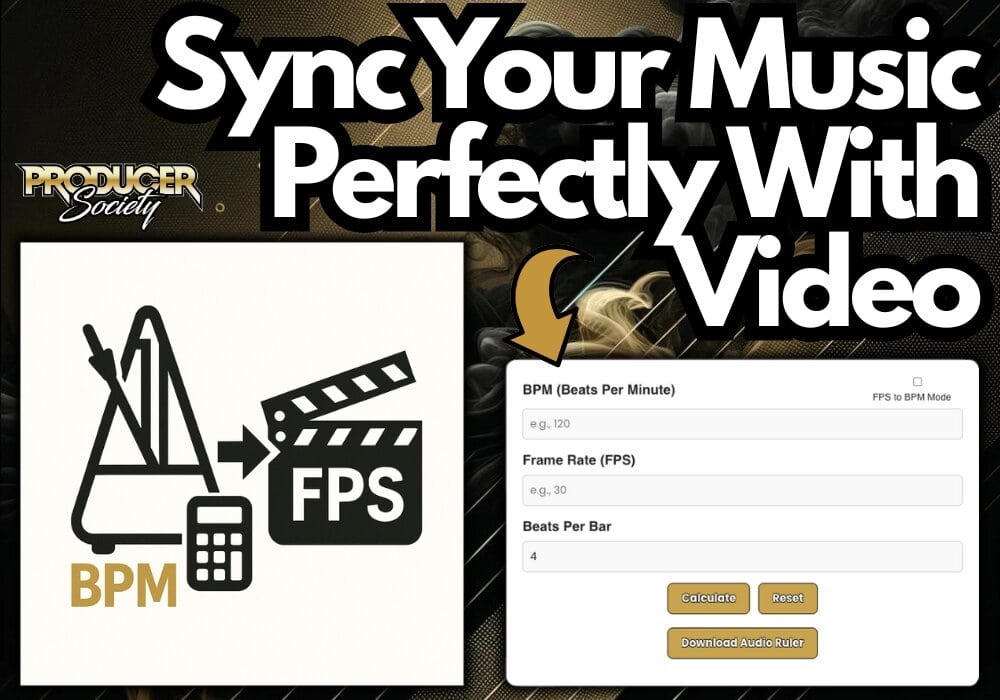BPM to FPS
Calculator
What The BPM to FPS Tool Is For
Enter a song’s BPM, beats per bar, and your project’s frame rate to get frame-accurate beat times. Use the results to line up cuts, transitions, and keyframes—and download a matching click track so you can edit to the beat in any editor.
Figure Out Your BPM First
If you don’t already know your BPM, you can use this one down below which is the same one from my other page, the BPM (Tap Tempo) Calculator.
Tap This Along to Your Song to Find Your BPM
Calculate BPM Manually
How to Use the Audio Ruler
1) Enter Your Values
- In BPM mode (default), type your song’s tempo (e.g. 120) into the BPM field.
- Make sure your Frame Rate (FPS) is set to your video’s frame rate (e.g. 30).
- (Optional) Change Beats Per Bar if your song isn’t in 4/4 time.
2) Calculate
- Click Calculate (or press Enter).
- You’ll see:
- Seconds per Beat
- Frames per Beat
- Seconds per Bar
- Frames per Bar
3) Download the Audio Ruler
- Click Download Audio Ruler.
- A 1-minute WAV file of evenly spaced “clicks” at your BPM will download.
- The filename will be
Ruler-<BPM>BPM.wav.
4) Import into Your Editor
- Drop or import that WAV into your video-editing timeline.
- Align the first click to your first beat.
- You can now visually match cuts and transitions to the beat grid.
5) Tips & Notes
- BPM Range: Supports integer BPMs from 20 to 400.
- Decimal BPMs: If you need, round to the nearest whole number (e.g. 118.5 → 119).
- Mobile Browsers: On iOS Safari the file may open in-browser; use “Save to Files” if prompted.
- Reset: Hit Reset (or Esc) to clear all fields and start over.
How It Works (The Math)
The calculator uses the following formulas:
- Seconds per Beat = 60 / BPM
- Seconds per Bar = (60 / BPM) × Beats per Bar
- Frames per Beat = (Frame Rate × 60) / BPM
- Frames per Bar = (Frame Rate × 60 × Beats per Bar) / BPM
These calculations ensure that your visual edits correspond precisely with the musical timing, enhancing the overall synchronization and flow of your project.
3 Real-World Examples
1) Music Video Editing
You’re editing a music video at 24 FPS. The track is 120 BPM.
- Result: 500 ms per beat, 12 frames per beat
- You can align every kick drum or snare to frame 0, 12, 24, 36, etc., on the timeline.
2) Instagram Reel Syncing
You’re creating a Reel at 30 FPS and the backing track is 100 BPM.
- Result: 600 ms per beat, 18 frames per beat
- You can cut to the beat every 18 frames to maintain perfect rhythm visually.
3) Instagram Reel Syncing
You’re creating a Reel at 30 FPS and the backing track is 100 BPM.
- Result: 600 ms per beat, 18 frames per beat
- You can cut to the beat every 18 frames to maintain perfect rhythm visually.

